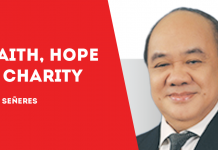
IT’S ALWAYS good to talk about anti-poverty programs, but for me, I would prefer to look at it from a positive angle, and the more appropriate terminology I think is pro-prosperity.
This is actually just a matter of semantics, because I think we should not just work towards reducing poverty, we should also work towards increasing prosperity. On that note, I would again take this opportunity to draw the line between poverty reduction and poverty alleviation, a fine line that has been difficult for me to explain so far.
On my part, I think that I have explained it well enough, but so far I have not gotten any feedback that it is already well understood.
In theory, any family that could not afford to buy the imaginary “basket of goods” in the conventional method of poverty measurement is considered below the poverty line, meaning that they are statistically poor.
Yes, this is all about statistics, and it goes without saying that our goal in poverty reduction should be to reduce the number of families that are falling below the poverty line. In other words, poverty reduction should be a numerical goal, and that is to physically elevate as many families as possible, so that they would fall above the poverty line, in effect graduating from below that line.
On the other hand, poverty alleviation is not a numerical goal, because there is no way to measure it in a quantitative manner. As I understand it, poverty alleviation includes all activities and services that would make the state of poverty more bearable.
In other words, it would make the poor people more comfortable, but it would not elevate them from poverty and in the final analysis, the poverty rate would remain the same. To illustrate my point, poverty alleviation would be like administering a pain killer to a tumour patient, and poverty reduction would be like a surgical operation to remove the tumour itself.
As far as I know, poverty statistics are gathered only at the national level, and apparently very few local government units (LGUs) are gathering their own local poverty data. One way or the other, any discussion about poverty reduction would always bring in the subject of public services delivery.
One thing for sure, there is already a consensus that the delivery of public services should not be considered as part of poverty alleviation, because the government is actually duty bound to deliver these services, whether or not there is a need for poverty alleviation or not. What this means is that the government should really have separate programs for poverty alleviation only, instead of presenting the delivery of public services as the substitutes for such programs.
After all is said and done, it is livelihood that is the bottom line of the poverty reduction issue, either in the form of employment or entrepreneurship or both. The bottom line is the augmentation of family income, because it is the increase in income that would enable these families to rise above the poverty line. When it comes to employment, there is no other choice except to create new jobs.
Similarly, when it comes to entrepreneurship, there is no other choice except to create new markets. There is more to this than meets the eye however, because the bulk of jobs and markets are abroad. Either that, or these jobs and markets are away from where the applicants and the producers are, even if they are just in the Philippines.
As it is now, many LGUs already have their own Public Employment Service Office (PESO) but very few seem to have put up their own Small and Medium Enterprise Development Office (SMEDO). SMED is a project of the Department of Trade and Industry (DTI) and it is good for them to have started it, but it is about time that the LGUs should do it on their own, in much the same way that they are now using their own PESOs that are already independent from the Department of Labor and Employment (DOLE). Of course, the DTI would always be there to help, but more heads are always better than one.
I am very thankful that I did not go into the business of selling website services, because now I am able to provide these website services for free. I could actually provide this service for free also to any business or advocacy, but in particular, I would really want to give this to all the PESO and SMEDO units of the LGUs, for purposes of going into ecommerce for job placement and product marketing purposes. The same service could also be given to the Business Permit and Licensing Office (BPLO) of the LGUs, the same unit that would usually grant licenses to operate local tricycles.
All told, the PESO, SMEDO and BPLO units of the LGUs could really use these free website services so that their poor residents could earn more incomes, the only way really for them to elevate themselves from below the poverty line. Of course, going into ecommerce is easier said than done, but by having access to free ecommerce sites, they would have won half the battle already. By the way, the websites that I am giving away are also capable of issuing ID cards, backed up by a database system and a social networking that they could use to engage their residents./PN

